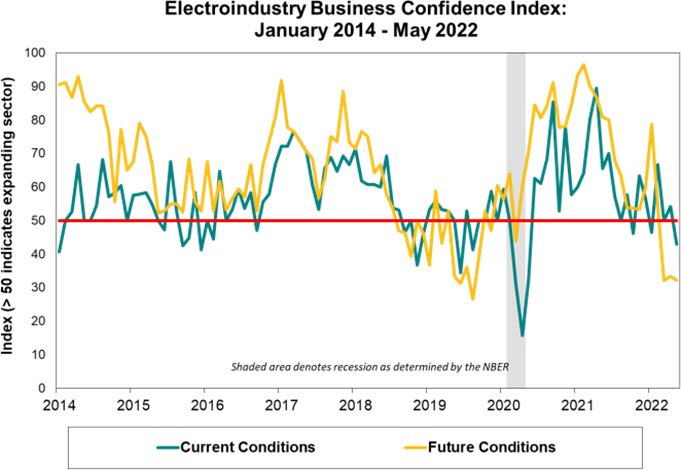June 6, 2022
Industry Confidence Has Become "Rather Wobbly"
"Turbulence now, more turbulence to come," says NEMA
Each month, the National Electrical Manufacturers Association (NEMA) publishes the Electroindustry Business Confidence Index (EBCI). The index is based on surveys of senior managers at NEMA member companies – designed to gauge the business environment of the electroindustry in North America. Member companies include most of the ten largest lighting manufacturers in North America, along with other manufacturers of lighting and electrical products.
This most recent ECBI shows the number of negative sentiments recording the highest reading in many months. Below are the details:

Turbulence now, more turbulence to come
Confidence has become rather wobbly of late as the current conditions component fell below 50 for the second time this year and hit its lowest level since right after the end of the recession. An 11-point shift from last month left May’s current conditions reading at 42.9 as now more than one-third of respondents reported “worse” conditions during this survey period. Lockdowns in China and other ongoing supply chain problems have bedeviled electrical manufacturers.
Now added to that mix, one commenter noted the deleterious effects soaring energy costs and U.S. tariffs are having on business conditions. Not all was negative, however, as some panel members noted their companies experienced better than expected orders activity.
The median and mean reported magnitude of change in current electroindustry business conditions both dropped below zero this month. The median score lost half a point from last month, sliding from 0 to -0.5. Coming from a higher starting point, the mean value also declined 0.5 scale points as it fell from +0.4 in April to -0.1 this month.
Panelists are asked to report the magnitude of change on a scale ranging from –5 (deteriorated significantly) through 0 (unchanged) to +5 (improved significantly).
The future conditions component has remained range-bound in the lower thirties for the last three months now as the May reading came in at 32.1. The list of potential pitfalls expected to affect the electroindustry and shared by commenters is long. Most of the challenges noted are ongoing, including rising inflation and interest rates, Covid-19, labor and materials shortages, supply chain snags, and geopolitical concerns. Looming disruptions include turmoil surrounding mid-term elections and the potential for work stoppages surrounding the ILWA-PMA contract negotiations.
SURVEY RESULTS:

- Values reflect the percentage of respondents expecting "Better" conditions, plus one-half of the percentage of respondents expecting "Unchanged" conditions.
- A score of 50 or higher suggests conditions appropriate to expansion of the electroindustry sector.
- Please note that survey responses were collected from the period of May 10-20, 2022.
EBCI METHODOLOGY:
The EBCI indexes are based on the results of a monthly survey of senior managers at NEMA member companies and are designed to gauge the business environment of the electroindustry in North America (defined here as the United States and Canada).
The survey contains the following questions:
- How would you rate current economic conditions in North America, as they affect your business, compared to the previous month?
- Using the following scale, please describe the magnitude of change in economic conditions in North America this month compared to economic conditions last month? [Scale structured as follows: 5 (improved significantly), 4, 3, 2, 1, 0 (stayed the same), -1, -2, -3, -4, -5 (deteriorated significantly)]
- How do you expect economic conditions in North America, as they affect your business, to have changed six months from now?
Respondents are asked to indicate whether conditions are better, worse, or unchanged. The survey also provides space for respondents to comment on current conditions. These comments are included below the table containing the index levels.
The index value is the percentage of respondents expecting “Better” conditions, plus one-half of the percentage of respondents expecting “Unchanged” conditions, which follows the methodology used by the Institute for Supply Management (ISM; formerly the National Association of Purchasing Management) in the construction of their manufacturing index.
Reprinted by permission of the National Electrical Manufacturers Association (NEMA)











